RIDE WITH US



BIKES FOR LIFE






THE NEED FOR BIKES THAT ARE BUILT TO LAST





























THE NEED FOR BIKES THAT ARE BUILT TO LAST



















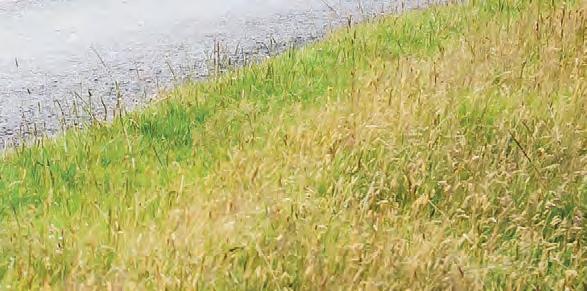




88 A MONTH!*

Wear and tear is a by-product of owning a bike. Assuming you ride it. Years ago, when I used social media, people I sort of knew kept adding me to a group dedicated to retro mountain bikes. I kept leaving it. The images of box-fresh bikes from the 1980s and ’90s did nothing for me. They were frozen in time, dead, like insects in amber.
Bikes change. We swap in parts we prefer. We replace the parts that wear out. My oldest bike is a Brompton from 2001. As well as all the usual, it’s had a new handlebar, new wheels (the first rims lasted 20 years) and a new rear triangle. It’s a proper ‘Trigger’s broom’.
Bikes don’t last forever but, as long as parts are available, we can keep them running. It’s easier with some than others. A super-lightweight road bike might only last a few years, a heavy-duty steel roadster decades.
That doesn’t make the shorter-lived bike a dead loss. Maybe it gave a few summers of cycling joy? When my titanium mountain bike developed a terminal crack in the down tube, I was phlegmatic. The frame cost £1,400 and lasted just seven years, but I’d had £16 a month’s enjoyment from it and more.
Its parts live on in other bikes. Some are scuffed, none pristine. I’m fine with that. In his book, Just Ride, Grant Petersen creates a compound word, ‘beausage’, from beauty and usage, suggesting the former comes from the later. My bikes have this. None gleams on Instagram. Bikes are for riding, not for displaying on real or virtual walls.
DAN JOYCE Editor
32 An adventure unfolds
Touring northern France on custom Bromptons

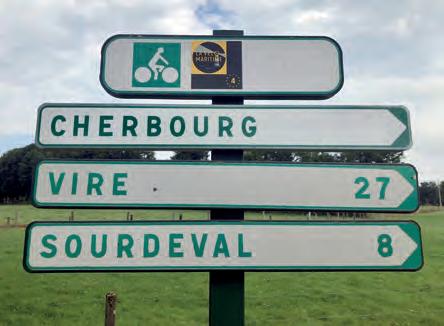
38 Built to last
How and why to build bikes with a longer life
49 Ride with us
Groups giving others the gift of cycling
52 The show on the road
Cycle-touring a poetry show around England
18 Shop Window
New products previewed
20 Gear up
Components, accessories and books
60 Endurance road bikes
Ribble Endurance SL Disc and Light Blue Wolfson 105 on test
66 Ridgeback Expedition
When it comes to touring bikes, 26 ain’t dead
69 Hip packs
Remember bumbags? They’re back
04 Freewheeling
Bits and pieces from the bike world
07 This is Cycling UK
Pedalling politics at the party conferences; the legacy of the UCI World Championships in Glasgow; how Cycling UK is breaking down barriers to cycling; and more
16 You are Cycling UK
Professional dog-walker Lydia Maxwell
29 Letters
Your feedback on Cycle and cycling
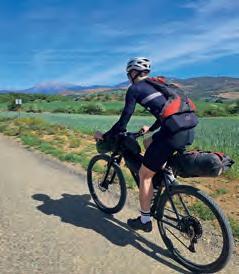
46 Weekender
A traffic-free coast-to-coast across Scotland

56 Cyclopedia
Questions answered, topics explained

73 Travellers’ Tales
Cycling UK members’ ride reports
01483 238300. Cycle promotes the work of Cycling UK. Cycle’s circulation is approx. 51,000. Cycling UK is one of the UK’s largest cycling membership organisations, with approx. 70,500 members and affiliates.


President: Jon Snow Chief Executive: Sarah Mitchell. Cyclists’ Touring Club, a Company Limited by Guarantee, registered in England No 25185, registered as a charity in England and Wales Charity No 1147607 and in Scotland No SC042541. Registered office: Parklands, Railton Road, Guildford, GU2 9JX.
CYCLE MAGAZINE: Editor: Dan Joyce E: editor@cyclinguk.org Designer: Christina Richmond Advertising: Bevan Fawcett T: 0203 198 3092 E: bevan.fawcett@jamespembrokemedia.co.uk Publisher: James Houston. Cycle is published six times per year on behalf of Cycling UK by James Pembroke Media, 90 Walcot Street, Bath, BA1 5BG. T: 01225 337777. Cycle is copyright Cycling UK, James Pembroke Media, and individual contributors. Reproduction in whole or in part without permission from Cycling UK and James Pembroke Media is forbidden. Views expressed in the magazine are those of the individual contributors and do not necessarily reflect those of the editor or the policies of Cycling UK. Advertising bookings are subject to availability, the terms and conditions of James Pembroke Media, and final approval by Cycling UK. Printed by: Acorn Web Offset Ltd, Loscoe Close, Normanton Industrial Estate, Normanton, WF6 1TW T: 01924 220633
UK: Parklands, Railton Road, Guildford, GU2 9JX E: cycling@cyclinguk.org W: cyclinguk.org T:
Cycling UK trustee Paul Baker outlines some of the highlights from this year’s annual report, where we look back at what we’ve achieved in the last financial year (April 2022 to March 2023)

This is the final year in our current strategy and so we’re pleased to be on track to meet our target of reaching one million more cyclists, which includes people who are discovering or rediscovering cycling. Last year was a period of change in the policy and campaigning world, but we had some great successes in our campaigning against that backdrop. Read on for a rundown of some of our highlights from the year just gone.
71,000 cycling UK members
28% are women 34 is the average age of new members
241 people celebrated 75 years or more with us

This year we completed our membership review, which underlined the value of our membership offer to its existing audience. Based on this, we’ve continued to refine what we offer to give members more of what they value most. We’ve also started to develop and test complementary offers for those who aren’t interested in membership but do want to continue to be involved with our work as a charity.
Thanks to our behaviour change programmes we are reaching more non-regular cyclists than ever before. This year 46% of participants did not cycle regularly before being involved in our projects. Our figures show clearly that we are encouraging more people to cycle and that many are swapping their cars for bikes for short journeys. It’s an achievement we are really proud of.
We are also reaching an increasingly diverse range of people. With more than half of our project participants being women and 30% from black and minority ethnic backgrounds, we have evidence that cycling really can be enjoyed by all of us. Winning the tender to deliver the government’s e-cycle trials in
Before taking part in a Big Bike Revival event with Broadmead Community Church in Northampton, John relied on his car because he didn’t feel it was safe to cycle locally. After attending a led ride and servicing the family’s bikes, he’s now keen to get out more together and has started cycling for some of those local journeys that he used to drive. He explained:
“We’re now all safe to ride. We spend time together, which means healthy and happy children.”
65,000+ people at bike repair activities, led rides and events across England
46% were not regular cyclists already
England was an exciting development this year. The Making cycling e-asier project runs in four cities, has proved incredibly popular and is already building the evidence base for e-cycles as a viable alternative to the car for many people, of all ages and backgrounds.
The year has seen our EXPERIENCE project draw to a close. It was funded by the EU Regional Development Fund’s EXPERIENCE project, which supported the creation of three of Cycling UK’s long-distance bikepacking routes – the West Kernow Way, the Cantii Way and the Rebellion Way.

This year it’s been a challenge just keeping up with the fast-moving world of policy in all four nations! But our policy and campaigns team has risen to the challenge. They’ve been well ahead of the increasingly divergent politics in the devolved nations and have supported our growing Cycle Advocacy Network to campaign successfully in their local areas. Most recently, we’ve been campaigning jointly with the Walking and Cycling Alliance to reverse the devastating cuts to active travel funding in England, announced by the transport secretary in March.
85 elected councilors in Scotland pledged their support for cycling ahead of local elections in response to our call for action
2,000 letters were written calling for the continuation of the National Dashcam Safety Portal in Scotland
3,399 member group volunteers
4,015 affiliate group volunteers
reviewing the overall direction. We purchased a training platform to establish role-specific pathways for our direct volunteers. We have also devised and delivered a bespoke ride leader training course for our member groups, which will enable consistency and compliance within our groups’ delivery on the ground.
927 direct volunteers
8,281 total number of volunteers
None of this work would have been possible without our brilliant teams working in finance, IT, HR, volunteering and project management. This year we continued to invest in our back-office support. It’s been a lot of work but is paying off: our online portal now enables those who wish to do so to manage their own membership online; our new database provides all our audiences with timely and relevant information; and our project management support means we can track and organise our many different areas of work across the whole country.
Our volunteer network is crucial to our success so we have been advancing our current training options and

Over the last six months we’ve started work on a new strategy for Cycling UK. We’re taking our time over it because we want to hear from a wide range of people inside and outside the organisation about what they think the future holds for cycling and what our role could be in this. We’ll continue to share our thinking on this as it progresses, and we look forward to publishing the new strategy in 2024. The current strategy is to reach one million more cyclists. Now we want to build on our successes, grow our influence and make an even bigger difference to encouraging cycling in the UK.
One thing we are all agreed on is that cycling is as important now as it has ever been, and has an essential role to play in preventing climate change, boosting the nation’s health and increasing the fun in all our lives.
Thank you to all our brilliant staff, our dedicated trustees, our thousands of committed volunteers and our members for another incredible year for Cycling UK. We are really looking forward to developing our future direction with you.

Their US holiday postponed, Harry Lyons and Celia Parker spent two weeks touring along the northern coast of France on customised Bromptons
Details

Where: France
Start/finish: Roscoff to Sourdeval
Distance: 400 miles/640km
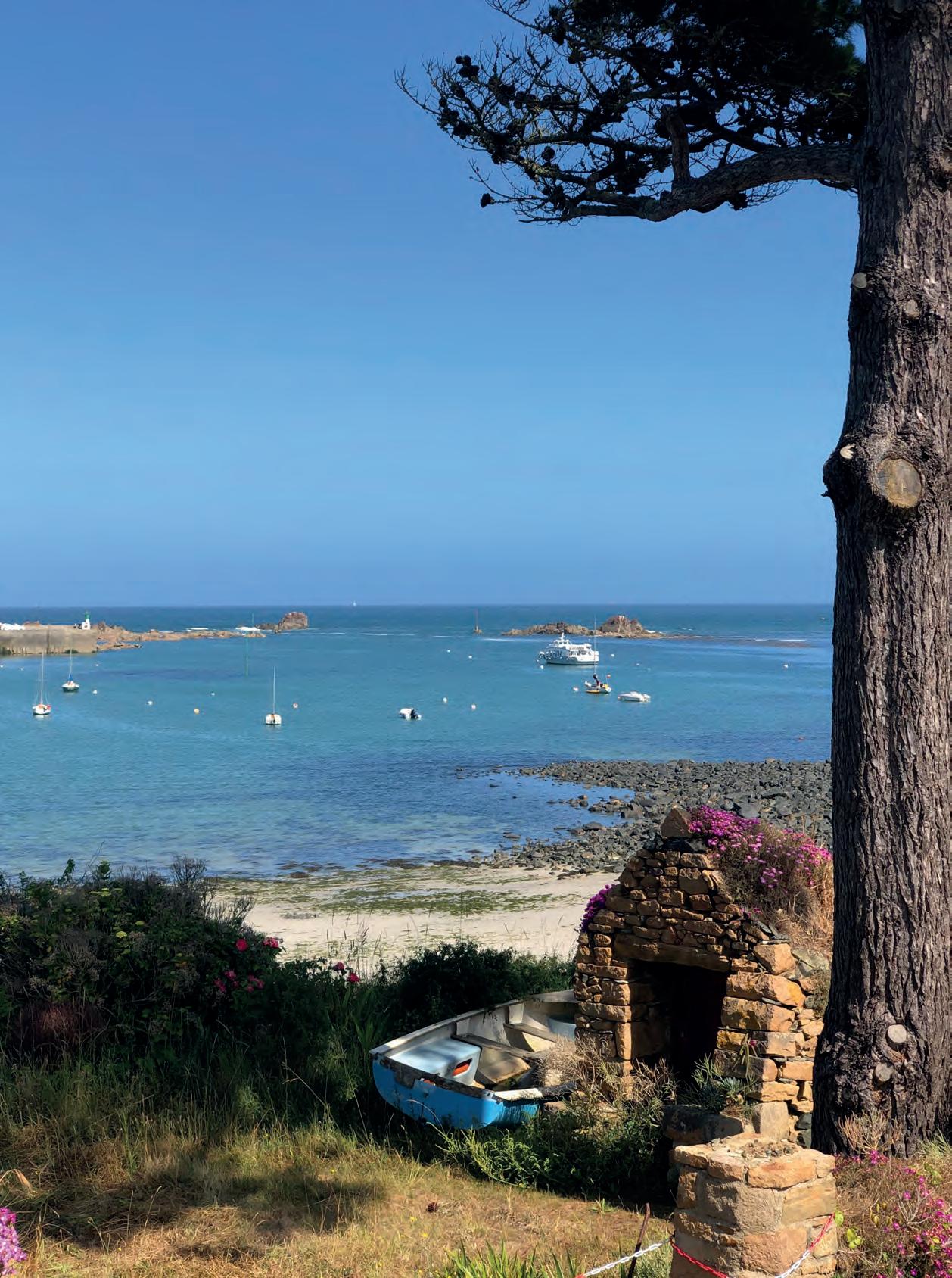 Photos: Harry Lyons & Celia Parker
Overlooking the Anse du Diben
Photos: Harry Lyons & Celia Parker
Overlooking the Anse du Diben
Cycling UK members whose tours have included North and South America, Europe, and Asia


Bikes folded nearby, we sat in the mid-morning sunshine at a café in Roscoff, Brittany. Behind us was a group of animated young people with cabin cases, who were smoking and drinking. It was only when one of them gave a cheery “Hello” that I realised that they were the crew from the overnight ferry we’d caught from Plymouth. Having arrived at 6.30am, we’d already explored the town centre and a local beauty spot before settling down to a beer and brunch ourselves.
My partner Celia and I were on a new adventure, aiming to cycle the small roads of the Brittany coastline from Roscoff to Saint-Malo, across Normandy to Caen, then take a train to Paris and the Eurostar home. The pandemic had disrupted our plans to cycle Route 66 from Los Angeles to Albuquerque so we’d used our holiday money to buy customised Bromptons with Rohloff hubs and disc brakes. They were certainly special but how would they cope with a two-week tour?
We felt pretty smug cycling to our local station, folding the bikes and shouldering our two pieces of luggage for a journey on the Elizabeth Line to Paddington. We were even more smug when we did the same thing to board a GWR train to Plymouth, avoiding the need to reserve one of the (maximum) four bike spaces available on its intercity trains.
Our luggage was minimal. We each had a front bag, plus a trunk bag for the rear carrier. Celia seemed to carry more in her 14-litre front bag than I managed
in my 25-litre one. But our limited luggage capacity meant no camping gear. We were taking a chance on early-season hotel availability.
Check-in at the Brittany Ferries terminal was straightforward, and we boarded with foot passengers, the bus dropping us next to a lift on the car deck. On board, the bikes were safely stored in the ship’s luggage locker.

The ferry’s dawn approach to Roscoff was lovely. As the medieval town was still asleep, we decided to explore a little. We cycled along deserted roads to the Pointe de Perharidy, a peninsula with beautiful wild beaches and great views across the bay to the distant town.
Back in Roscoff, after an early check-in at our hotel, we were ready for a beer and a sandwich. The café favoured by the Brittany Ferries crew was a good choice, facing a harbour from which small ferries (vedettes) ran boat trips to the nearby Île de Batz. It was €10 return, dogs free and bikes €16. It was worth taking our bikes with us to explore the island… and get lost, despite its small size. There’s a spectacular botanic garden on the Île de Batz – and another on the mainland, just up the road from the ferry terminal.
Before we left Roscoff we had somewhere we had to see: the Maison des Johnnies & de l’Oignon de Roscoff, a small museum telling the story of the bikeriding ‘Onion Johnnies’, with their strings of onions that they delivered to British households. It brought tears to our eyes.


Next day we set out on small lanes for Morlaix, keeping the sea in view where possible. It was a pleasant ride past fields spiky with artichokes, and we arrived at the port in time for lunch. The approach along the river was scenic, as was Morlaix itself, located in a




We were lucky to obtain singlespeed Bromptons during the pandemic bike drought. They were delivered directly to Ben Cooper at Kinetics in Glasgow for modification, getting new forks and rear triangles to accept disc brakes, Rohloff hubs and Gates belt drives. Tyres are 50-305 Schwalbe Big Apples.
The bikes coped with some rough terrain and, complemented by Ergon Comfort handlebar grips, were comfortable on tarmac. I went for a SON hub dynamo. Celia didn’t due to the extra weight and (admittedly minimal) drag. Supply chain problems meant that we ended up with Magura hydraulic disc brakes, which I don’t like. There’s virtually no adjustment and they’re less easy to repair roadside than cable discs. kineticsonline.co.uk







Richard combines a love of cycling with a deep passion for the environment


BIKES ARE SOLD ON PRICE AND/OR PERFORMANCE. LONGEVITY? NOT SO MUCH. RICHARD SCRASE ASKS HOW, WHY AND WHEN WE SHOULD DESIGN FOR DURABILITY
Building a bicycle requires raw materials, sophisticated machinery, skilled labour and energy. A typical bike burns up between a quarter and a third of a ton of carbon as it’s made. So it’s a great shame, as well as a terrible waste, if the lovely, shiny new bike displayed for sale fails to give years of service. Lots of bikes end up breaking down sooner than they should, and many are abandoned altogether as a result.
Bike recycling projects such as Cycling UK’s Big Bike Revival can get some of these bikes back into circulation. I experienced this during the Covid period. During lockdown, I was one of a dozen or so Cyclox volunteers in Oxford repairing donated bikes for key workers. Between us we put more than 450 bikes back on the road.
It could have been many more but for a few frequent faults that were too expensive for us to repair. One of the worst of these were worn bottom brackets. Punctures, corroded cables and worn-out chains were also pretty common but these were easy to fix. Even when worn bottom brackets could be repaired, the cost in time and resources usually exceeded our budget.
S o how could bikes be designed to stand up better to usage, neglect and
weather? My colleagues at Cyclox and I had some ideas, but I decided to ask some experts – bike makers who are aiming to make bikes that last.
Richard Delacour of Oxford Bike Works (oxfordbikeworks.co.uk) sets out to make bikes that can be used – and have been used – to cycle around the world. I asked him about his choice of components and how he’d arrived at them.
“A lot of it is trial and error,” he said, “learning from the feedback given by customers. Shimano is a dominant force in the gears and transmission market, and by and large, makes very reliable components. When I set up in business I took advice from seasoned cycle tourists who had tested components exhaustively.
“ Nowadays, I have a reliable network of customers who let me know how they are getting on. I have a principle that if a component fails unexpectedly, I substitute it for something else straight away, so that I don’t end up knowingly fitting a component that has recently failed to another bike.
“ Steel frames are much more resistant to fatigue than aluminium and carbon, and should last 20-30 years if looked after. Steel also has a certain springiness and the ability to absorb shocks, whereas other frame materials are stiffer and so

Ask us at cyclinguk.org/bikefinder
For: Jonny Blake, aged 25, from Central London Bike needs: Commuter bike for work in London Must haves: Straight handlebar. Easy maintenance. Space for mudguards Must not have: Nothing Budget: £500





 Simon Withers
Simon Withers

In an ideal world and for low maintenance I’d like to recommend a hub-gear bike, but price largely puts them out of the equation, though the Vitus Mach 1 Three (£519.99, vitusbikes.com) nearly hits your price point. But my final choice covers most of your requirements and even gives you a little change from your £500.
I’ve ridden a lot of Carrera Subways over the years and their performances far exceeded their quite modest prices. The Carrera Subway All-Weather Edition looks like being no exception (£485, halfords.com – but members can get an 8% discount on selected Halfords bikes, see cyclinguk.org/halfords) Not only does this aluminium-framed flat-bar bike come with full-length mudguards, the spec also includes automatic lights (I’d recommend an extra front light at least) and heated grips.
I’m not sure how crucial they are but, unusually and very impressively at this price, you also get hydraulic disc brakes, which will be a real boon in London’s traffic, as well as an exceptionally good gear range from the 2×9 Shimano Tourney setup. The low bottom gear from the 30/36 pairing – a wallclimbing 22in – will also go a long way to ameliorating the effects of the Subway’s 14.5kg weight.
The 27.5in tyres have a healthy 1.95in width that’ll put a big cushion of air between you and even the poorest city surfaces, so you won’t be battered by the road. Reflective frame and mudguard decals and reflective strips on the tyres will aid your visibility to other road users during night-time commutes.
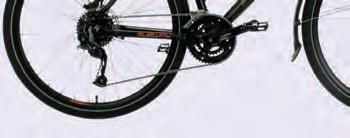 Dan Joyce
Dan Joyce

Central London is flat enough that you can dispense with variable gears – and the need to maintain them. You see a fair number of fixie riders in the capital for those reasons. Skinny tyres aren’t optimal for London’s potholed and patched-up roads, however; wider rubber will give a safer, more comfortable ride.
The Vitus Mach 1 One City Bike SS (£399.99, vitusbikes. com) – a stablemate of the hub-gear model Simon mentions – is an urban mountain bike with 27.5×1.95in tyres. I tested its predecessor, the Vitus Dee 29, in the Feb/Mar 2017 issue of Cycle (cyclinguk.org/cycle/bike-test-vitus-dee-29), riding it on road and off. The Mach 1 One looks equally robust.

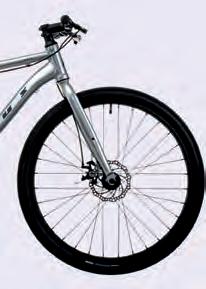
Its Alhonga mechanical disc brakes are not as powerful as the Carrera’s hydraulics but they should be effective enough, and are not hard to maintain. Just dial in the fixed piston and adjust the cable tension as the pads wear. The singlespeed drivetrain should need no attention beyond occasional oiling. With a 38-tooth chainring and an 18t screw-on freewheel, the gear is 58in. If that's too spinny, fit a 16t one (approx £15) for a 65in gear.
The Mach 1 One doesn’t come with mudguards but does have fittings for them, as well as for a rear rack. Frame-fitting guards like the SKS Bluemels Basic 28" 65 Mudguard Set (£42) will give more wraparound and keep you cleaner.
Theft is a big problem in London so I’d recommend spending most of the rest of your budget (~£50) on a short-shackle Sold Secure Gold-rated D-lock from the likes of Abus or Kryptonite
MEMBERSHIP FROM JUST £3. 88 A MONTH!*
MEMBERSHIP FROM JUST £3. 88 A MONTH!*







First look Traditional-style road bike with a classy Reynolds 853 frame and ‘actually fine’ rim brakes

DAN JOYCE

Dan is 177cm tall (5ft 9 1/2in) and weighs 63.5kg (10st). He rides with his local club’s fast group, despite unfashionably high handlebars on all his bikes
Steel or carbon? Rim brakes or discs? Dan Joyce tests two very different £2,000 road bikes from Light Blue and Ribble
An endurance road bike is essentially an audax bike with marketing glitter. It’s a road bike designed not for racing but for efficient and comfortable mile eating – sportives, club rides, winter training, maybe long-distance commuting. Such bikes ran 25mm or 28mm tyres before they were adopted by racers, with room for mudguards to boot. Gears may (should!) go lower, and the handlebar may be higher so you’re not forced into an uncomfortable racing crouch.
Many endurance road bikes are nevertheless too racy for my tastes: a steeper-than-optimal seat tube angle tips you forward onto a handlebar that’s still too low, due to a shortish head tube and a carbon or aluminium fork steerer that can’t be stacked with spacers… To address this, I often choose the next frame size up. This raises the handlebar (taller head tube) and also gives more toe room (longer front centres). Sliding the saddle back, if necessary, makes the effective seat tube angle shallower, while a shorter stem fixes what would be an overlong reach to the handlebar.
That’s why the Ribble in this test is a Large rather than the Medium I ‘should’ be riding. And
it’s why the stems are right at the top of the fork steerers in the photos. You have to be able to get the contact points where you want on a bike you’ll pedal for 50, 100 miles or more. It’s way more important the frame material or brake type. As it happens, frame material and brakes are two of the key differences between the bikes on test. The Light Blue Wolfson 105 R7000 has a steel frame, with rim brakes that are deep enough to clear mudguards, like the audax bikes of old. The Ribble Endurance SL Disc Sport has chunky and angular carbon frameset and hydraulic disc brakes, like a lot of contemporary race bikes, but it still takes mudguards.

Carbon fibre has a better strength-to-weight ratio but you can’t beat a skinny-tubed steel frame for aesthetics, especially when nicely painted. The Light Blue’s frame is in fact relatively light; the main triangle is Reynolds 853 and the stays are 725. This Medium frame is 1.7kg and the whole bike weighs less than the disc-braked Ribble. The Light Blue’s top tube is long for a mediumsized frame, which means the front-centres
distance is also longer – no toe overlap for me, although I did have to swap the 100mm stem fitted for an 80mm one. The down tube is biaxially ovalised to increase lateral stiffness at the bottom bracket and to reinforce it at the head tube. Dropouts are quick release, which still works fine for road bikes, particularly for lighter riders who don’t mash big gears.
I’m not keen on the Light Blue’s MTB-style full cable housing under the top tube; cable stops and bare cable here would look better. I’d prefer a metal head badge, too. But the other details are spot on. The mudguard mounts are hidden on the inside of the stays – as they are on the fork blades – for a neater look if you go without. And the frame maximises the room available under 57mm-drop callipers, with the blocks sitting in the bottom of the slots.
Space is tighter under the crown of the carbon fork. A mudguard does fit over the 25mm tyre but only just, and it needed careful adjustment to avoid rubbing. While carbon forks are ubiquitous on road bikes, I’d prefer a lugged steel fork here, similar to the one on Light Blue’s retro-style St John. It would be simpler to get the brake drop just right than with an off-the-peg carbon fork, and the ride could be more compliant;
LIGHT BLUE WOLFSON 105 R7000
Price: £1,984.99 as tested (frameset £899.99).
Sizes: S, S/M, M (tested), M/L, L.
you can see a lightweight steel fork’s tips moving over rough chipseal.



Ribble’s Endurance range includes steel, aluminium and titanium frames as well as carbon fibre, with a variety of specifications and brake types. The SL Disc Sport is the entry-level carbon model with discs. It feels a bit racier than the Light Blue. The frameset has prominent aero features: the down tube and seat tube are truncated aerofoils; the fork blades are aero; the seatstays have been dropped lower; cables are routed internally. Ribble’s website makes much of these improved aerodynamics. For an endurance road bike, however, I’d call them marginal gains.
The frame angles are within half a degree of the Light Blue’s, but size for size it has a shorter head tube and a shorter frontcentres. Upsizing to the Large enabled me to get the handlebar high enough for long-distance comfort. It didn’t quite eliminate toe overlap but would have done so without the front mudguard. Talking of which: clearance for them is no greater than that available with a 57mm sidepull. You’re limited to 25mm tyres with guards or 32mm without. It’s a strange constraint for a disc-brake bike.
Weight: 9.05kg/ 19.91lb (inc guards, no pedals).
Frame & fork:
TIG-welded, double-butted Reynolds 853 steel main triangle, Reynolds 725 seatstays and chainstays, with 130mm QR dropouts and fittings for mudguard, rear rack and two bottles.
Carbon fork with 1 1/8in aluminium steerer, QR dropouts and mudguard fittings.
Wheels: 25-622


Schwalbe One tyres, Halo Evaura wheels (tubeless-ready 19mm rims with 20 radial spokes on Halo RS front hub and 24 1×/2× spokes on Halo RS 6Drive rear hub.
Transmission: no pedals, 172.5mm
Shimano 105 R7000 crankset with 50-34 chainrings, Shimano SM-BBR60
Hollowtech II bottom bracket, Shimano HG601 11-speed chain, 11-28t Shimano R7000 cassette.
Shimano 105 R7000 STI shifters, Shimano 105 R7000 derailleurs. 22 ratios, 33-122in.
Brakes: Shimano 105 R7000 levers, Tektro Quartz callipers.
Steering & seating: Genetic padded cork tape, 420×31.8mm
Genetic Driser 4-10 handlebar, 100mm×6º Genetic stem, 1 1/8in Gusset threadless headset. Genetic STV saddle, 340×27.2mm Genetic STV seatpost, Allen bolt seatpost clamp.
Equipment: unbranded chrome-plastic mudguards (+£35). ison-distribution.com


I like how it looks and how it rides.
I'd consider buying it as a framesetTop: Both bikes have 11-speed Shimano 105, which I’d choose over the new 12-speed (see p4)
MEMBERSHIP FROM JUST £3. 88 A MONTH!*
MEMBERSHIP FROM JUST £3. 88 A MONTH!*









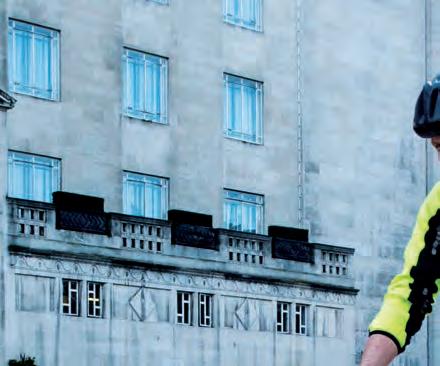




Bumbags were what many off-road riders use before hydration packs appeared. Now they’re back. Katherine Moore tests four

Hip packs, bumbags or (for Americans) fanny packs – whatever you call them, they’re gaining popularity among gravel riders, mountain bikers and bikepackers. More compact and lightweight than a backpack and offering more storage than many smaller on-bike bags, hip packs are being used for day rides and multi-day tours alike.
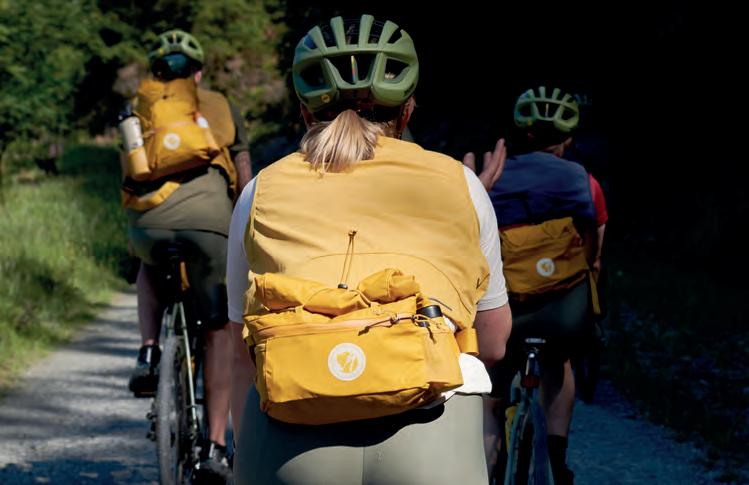
Most have room to stash your tools and spares, snacks and extra layers. This means you can ride in a technical T-shirt rather than needing a cycling jersey for pocket storage, yet still keep your valuables on your person rather than on the bike, which can be handy when going into shops and cafés.
Many mountain bikers have made the switch from rucksacks to hip packs as they offer a more lightweight and compact alternative, which can also help keep you cooler during the hotter, sweatier summer months.

While it can be tempting to opt for the biggest hip pack possible, there’s a balance to be had. Overloading a hip pack can put extra strain on your back, just as carrying a heavy rucksack might. If you plan on riding with a camera, a hip pack can be a good place to keep it stowed and safe, and can help to keep it dry during rain showers.
At Cycle, we are proudly independent. There’s no pressure to please advertisers as we’re funded by your membership. Our product reviews aren’t press releases; they’re written by experienced cyclists after thorough testing.
It’s wise to try on different options before you buy to see just how comfortable the straps are on your body. Wider straps tend to spread loads more evenly, and padding can also aid comfort.
Ranges from a couple of litres volume to six or more. The best option depends on whether you’re looking for something to store all your gear (tools, spares, snacks and layers) or just a few essentials.
Will you run bottles on your bike, store bottles
in your hip pack or use a hydration bladder and hose? If you’re heading somewhere really hot or remote, you might want to opt for more than one approach.
How durable your hip pack needs to be will depend on whether you ride on road or off, just in summer or year round. Look for waterproof materials and seam taping for the most weatherproof packs.
For ultimate comfort, look for options that have ventilation panels built in to avoid a sweaty lower back.
After her exams, Jude Wilkinson rode coast to coast from Morecambe to Bridlington
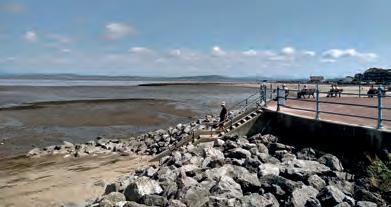
The 1,250km Sendero Histórico is challenging off-road route across northern Spain. Tom Goldsmith rode it

It was a winter’s evening when I chanced upon the GR1 route in Spain, which runs between the Picos and the Mediterranean. Here was a European off-road trail offering adventure and challenge reminiscent of the brilliant Rough-Stuff Fellowship Archive. But I could also package it as a holiday for, secretly, I was searching for a beautiful setting to ask my girlfriend to marry me.
The GR1 (or Sendero Histórico) is a 1,250km remote trail across northern Spain linking important historical sites. We took the published hiking route as inspiration, adapting it to fit our 11-day timetable and riding east to west between Girona and Bilbao for ease of access from the UK by plane and ferry. A real charm for us was no record of a previous route attempt by bike.
We set off armed with a walking guidebook (our thanks to Terry Hayes and Cicerone Press) as our only source of local knowledge. The scenery was beautiful and the terrain was varied, with fast dirt roads, sinuous singletrack and attritional hike-a-bike. We crossed rivers, explored abandoned mountain villages, napped in church doorways and sampled copious bocadillos. It was hard, but it was also an adventure.
Having no expectations of what might be around the next corner also meant nothing could disappoint us.
As Bilbao approached, our hunger to trailblaze a new cycle route gradually melted away. Instead, everything was in the discovering.

The trip exceeded our wildest bikepacking dreams, and we’d pushed well outside our comfort zones. Our bodies and kit both took a hammering on the extreme parcours. The experience will linger long in the memory, and I hope prompt some thoughts as to your own cycle touring ‘bucket list’ criteria. Adventure is in the eye of the beholder.
And the marriage proposal? Dear reader, she said yes.
THE WAY OF THE ROSES takes in the diverse landscapes of the Forest of Bowland, the Yorkshire Dales and the Yorkshire Wolds. On my approach to Settle, the scenery shifted completely. The open moors of Bowland gave way to dry stone walls and a gorge-like valley, which snaked its way from Austwick to Wharfe and finally Settle.
If you’ve ridden the route, you’ll remember the climb out of the town. Over a mile at 7.3%, most of the elevation gain is in the first third, which probably averages over 20%. I was determined to get up without walking, a task made easier by having mountain bike gears.
As I reached the top, though, I realised that I had consumed all my water. There were no shops nearby except back down the hill. I pulled into a village and trundled up to a man painting his cottage door.
“Excuse me, I’m sorry to disturb you, but I’ve run out of water.”
“Run out of water, have you?” replied a broad Yorkshire accent. “Well, give me the bottles, then.”
“Thanks, it’s kind of you. It’s quite the climb up there. Absolutely brutal in this heat.”
“I used to run up it.”
He disappeared inside the cottage and returned with my bottles refilled, along with a handful of bananas.


“Here you go. Lots of road cyclists come through the village, hordes of them. Anyway, have a banana, sit down on the bench over there. Take two minutes, enjoy yourself.”
Amused at the specified length of time, I used the full two minutes before setting off to find a camp site.
More online

Fancy contributing to Cycle?
Read the guidelines here: cyclinguk.org/be-part-cyclemagazine